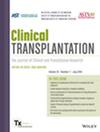Association of Community Distress With Lung Transplant Waitlist Acceptance
Abstract
Introduction
Access to transplantation is not entirely equitable with several studies demonstrating racial and socioeconomic disparities affecting the transplant process and thereby outcomes. Notably, few studies have focused on disparities prior to waitlisting. This study aimed to characterize the impact of community socioeconomic factors as measured by the Distressed Community Index (DCI) on acceptance for lung transplant waitlisting.
Methods
A retrospective review was performed on 463 patients evaluated for lung transplant waitlisting at our institution between 2016 and 2020. Community distress was calculated using the DCI, which yields a composite Distress Index (cDI) and includes data on various community characteristics. Statistical analysis was done using descriptive statistics and logistic regression methods.
Results
Of the 463 patients included, 333 (71.9%) were accepted and 130 (28.1%) were denied for waitlisting. The mean cDI was 42.5 (±30.0) and 44.8 (±30.8) (p = 0.45) for the accepted and declined groups, respectively, indicating mid-tier distress for both groups by DCI metrics. The cDI was not found to be associated with odds of waitlist acceptance (OR 0.997, CI 0.99–1.004, p = 0.455). Furthermore, there was no association between sex, race, ethnicity, public insurance coverage, or any of the subcomponents of the DCI and the odds of successful waitlisting at our institution.
Conclusion
This single-center retrospective evaluation found that cDI, as calculated by the DCI, and the DCI subcomponents were not associated with transplant waitlist acceptance. Future studies should be done evaluating community-level socioeconomic disparities and the utility of community disadvantage indexing tools in the lung transplant waitlisting process, with the intentions of conceptually expanding our understanding of the link between transplant outcomes and biopsychosocial candidacy.


 求助内容:
求助内容: 应助结果提醒方式:
应助结果提醒方式:


